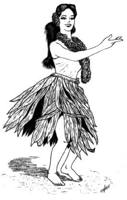
|
Folk Dance Federation of California, South, Inc.
|

|
CLICK AN IMAGE TO ENLARGE
Hula: A hula dancer; To dance the hula.
In the days of our Kupuna, the hula was a religious service in which poetry, music and the dance lent themselves, under the forms of dramatic arts.
In comparing the dance (hula) in ancient Hawaiʻi to our modern day hula, the ancient Hawaiʻians did not personally and informally indulge in the hula for their own amusement. The art and practice of the hula was an accomplishment requiring special education and training in both songs and dance. And more especially because it was a religious matter.
Kumu Hula: Hula Teacher
Hoʻopaʻa: Drummer and hula chanter (memorizer).
Olapa: Dancer, as contrasted with the chanter or Hoʻopaʻa.
Halau: Long House, as for canoe or hula instruction; hula school.
Oli: Chant that was not danced to, especially with prolonged phrases chanted in one breath, often with a trill (iʻi) at the end of each phrase.
Mele: Song, chant of any kind, poem, to sing, chant (preceded by both Ke and Ka); modern Hawaiʻian song.
Hoʻopaʻapaʻa: To make fast; drummer and hula chanter.
Pa: A sound; to sound; beat, rhythm, as of a dance; stroke, as of an instrument; thump of a gourd down on a pad, with one quick slap of the fingers as the gourd is raised; signal to begin the dance.
Kuku: Gourd beat; the gourd is thumped down on a pad three times, and on the third rise, it is slapped.
Hoʻomakaukau: To get ready.